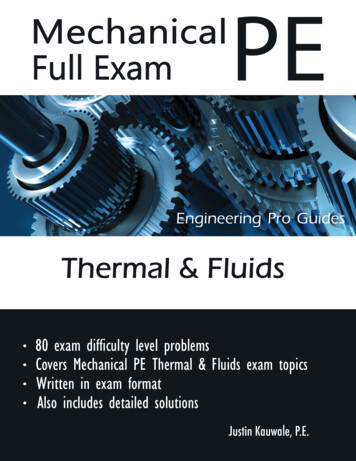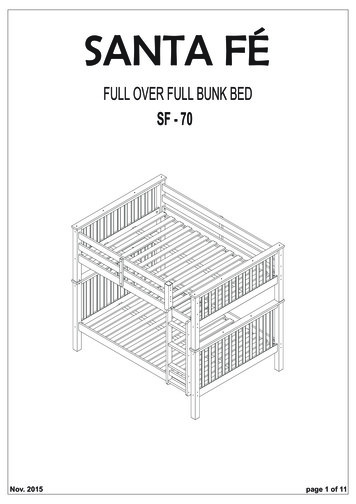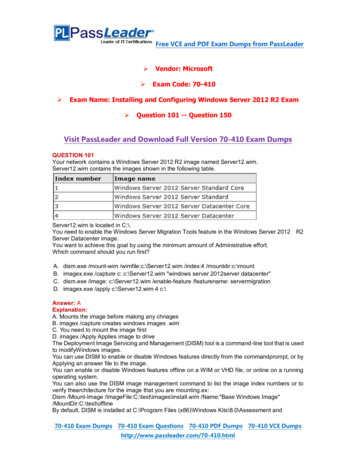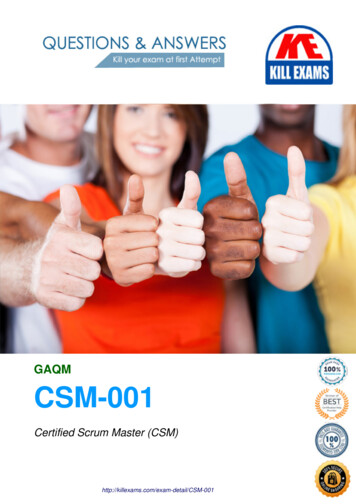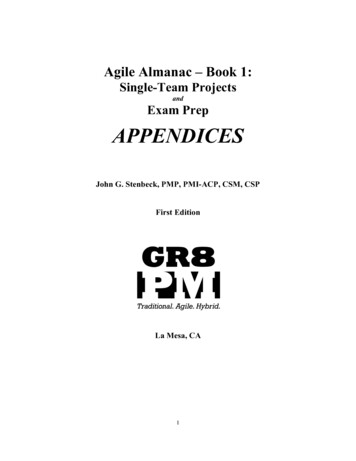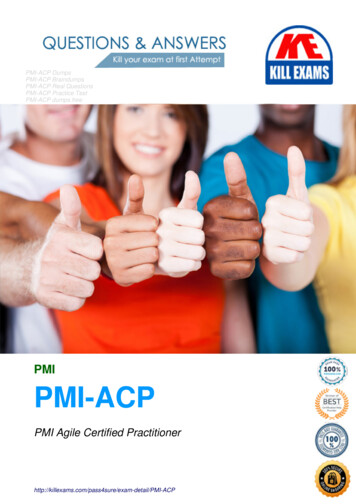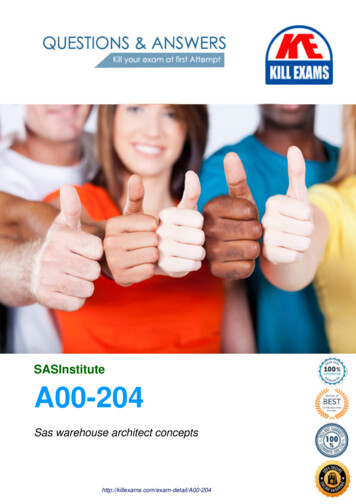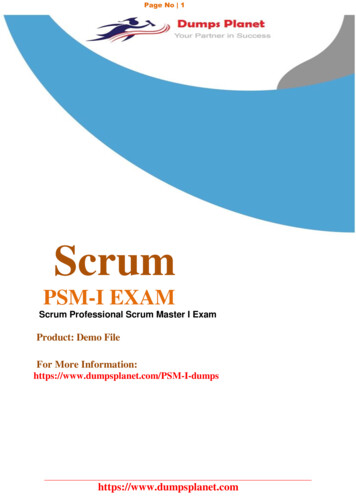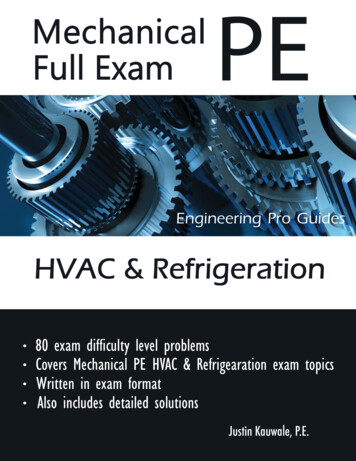
Transcription
MechanicalFull ExamPEEngineering Pro GuidesHVAC & Refrigeration80 exam difficulty level problemsCovers Mechanical PE HVAC & Refrigearation exam topicsWritten in exam formatAlso includes detailed solutionsJustin Kauwale, P.E.
SECTION 1INTRODUCTIONhttp://www.engproguides.com
1.0 INTRODUCTIONOne of the most important steps in an engineer's career is obtaining the professionalengineering (P.E.) license. It allows an individual to legally practice engineering in the state oflicensure. This credential can also help to obtain higher compensation and develop a crediblereputation. In order to obtain a P.E. license, the engineer must first meet the qualifications asrequired by the state of licensure, including minimum experience, references and the passing ofthe National Council of Examiners for Engineering and Surveying (NCEES) exam. EngineeringPro Guides focuses on helping engineers pass the NCEES exam through the use of freecontent on the website, http://www.engproguides.com and through the creation of books like thissample exam and technical study guides.This sample exam is intended to be a sample test on ONLY the key concepts and skills of theHVAC & Refrigeration Mechanical P.E. Exam.1.1 KEY CONCEPTS AND SKILLSThe key concepts and skills tested in this sample exam were first developed through an analysisof the topics and information presented by NCEES. NCEES indicates on their website that theP.E. Exam will cover an AM exam (4 hours) followed by the PM exam (4 hours). Within theMechanical Engineering field, there are three specialties to choose from for the depth exam:HVAC & Refrigeration, Thermal & Fluids and Mechanical Systems & Materials.This sample exam focuses on the HVAC and Refrigeration topic. NCEES indicates on theirwebsite that the HVAC and Refrigeration exam will focus on the following topics:(http://ncees.org/engineering/pe/):1) Principlesa) Basic Engineering Practice - (4 questions)i) Units and conversionsii) Economic analysisiii) Electrical concepts (e.g., power consumption, motor ratings, heat output, amperage)b) Thermodynamics - (4 questions)i) Cyclesii) Propertiesiii) Compression Processesc) Psychrometrics - (8 questions)i) Heating/cooling cycles, humidification/dehumidification, heating/cooling loads, sealevel and other elevationsd) Heat Transfer - (7 questions)e) Fluid Mechanics - (4 questions)f) Energy/Mass Balances (5 questions)2) ApplicationsMechanical PE - HVAC and Refrigeration Full ExamIntroduction -1http://www.engproguides.com
a) Heating/Cooling Loads - (8 questions)b) Equipment and Components - (18 questions)i) Cooling towers and fluid coolersii) Boilers and furnacesiii) Heat exchangersiv) Condensers/evaporatorsv) Pumps/compressors/fansvi) Cooling/heating coilsvii) Control systems componentsviii) Refrigerantsix) Refrigeration componentsc) Systems - (18 questions)i) Air distributionii) fluid distributioniii) refrigerationiv) energy recoveryv) control conceptsd) Supportive Knowledges - (4 questions)i) Codes and standardsii) Air quality and ventilationiii) Vibration controliv) Acoustics, economic analysis, electrical conceptsEach of these topics were investigated and filtered by the test maker for concepts and skills thatmeet the following criteria:(1) First, the concept and skill must be commonly used in the HVAC & Refrigeration field ofMechanical Engineering. For example, pump sizing, fan sizing, determining friction losses andcalculating net positive suction head are regular occurrences in the HVAC & Refrigeration field.The breakdown of question topics is shown in the list above.(2) Second, the skill and concept must be testable in roughly 6 minutes per problem. There are(40) questions on the afternoon exam and you will be provided with 4 hours to complete thetest. This results in an average of 6 minutes per problem. This criterion limits the complexity ofthe exam problems and the resulting solutions. For example, pressure drop calculations arecommon in the HVAC & Refrigeration field, but the calculation is often very lengthy because ofthe number of steps involved, especially if a unique fluid and flow condition is used. Thus,common fluids like water/air and common pipe/duct materials are used.(3) Third, the key concepts and skills must be used or be known by practicing HVAC &Refrigeration Mechanical Engineers. This criterion is similar to the first criterion. However, thiscriterion filters the concepts and skills further by limiting the field to material encountered andused by practicing engineers. The HVAC & Refrigeration, Thermal & Fluids and MechanicalSystems & Materials fields are vast and there are many different avenues an engineer can take.Two diverging paths are those engineers involved in research and those who practice.Mechanical PE - HVAC and Refrigeration Full ExamIntroduction -2http://www.engproguides.com
Research engineers are pushing the boundaries of the field and are highly focused in theirspecific area of the field. The Professional Engineering exam does not cover emergingtechnologies or highly focused material.(4) The P.E. Exam must test the principle or application of the skill and concept and not thederivations or the background knowledge of the topic or concept. The exam also does notcover background information on the NCEES topics. The P.E. Exam is meant to prove that thetest taker is minimally competent to practice in the Mechanical Engineering field. The exam isless concerned with theory and more with the principle or application of the theory, skill orconcept. For example, the P.E. exam is less concerned with the theory of evaporation in acooling tower and more with the performance and selection of a cooling tower.In summary, this book is intended to provide a sample of the necessary skills and concepts todevelop a minimally competent, practicing professional engineer in the Mechanical Engineeringfield, capable of passing the P.E. exam. This book does this through the following means:(1) Providing sample problems that can be completed in roughly 6 minutes per problem.(2) Providing solutions to these problems that teach skills and concepts used by practicingMechanical Engineers.1.2 UNITSThe primary units that are used in the P.E. Exam are United States Customary System Units(USCS). As such, this guide focuses exclusively on the USCS. However, it is recommendedthat the test taker have a conversion book, because certain areas of the P.E. Exam may use theInternational System of Units (SI).2.0 DISCLAIMERIn no event will Engineering Pro Guides be liable for any incidental, indirect, consequential,punitive or special damages of any kind, or any other damages whatsoever, including, withoutlimitation, those resulting from loss of profit, loss of contracts, loss of reputation, goodwill, data,information, income, anticipated savings or business relationships, whether or not EngineeringPro Guides has been advised of the possibility of such damage, arising out of or in connectionwith the use of this document or any referenced documents and/or websites.This book was created on the basis of determining an independent interpretation of theminimum required knowledge and skills of a professional engineer. In no way does thisdocument represent the National Council of Examiners for Engineers and Surveying views orthe views of any other professional engineering society.3.0 HOW TO USE THIS SAMPLE EXAMMechanical PE - HVAC and Refrigeration Full ExamIntroduction -3http://www.engproguides.com
This exam can be used in multiple ways, depending on where you are in your study process. Ifyou are at the beginning or middle, it can be used to test your competency, gain anunderstanding and feel for the test format, and help to highlight target areas to study. If you areat the end, it can be used to determine your preparedness for the real exam. Remember thatthe questions are a sample of the many topics that may be tested and are limited to fit a fullexam length and therefore is not comprehensive of all concepts.Because the exam is written to be similar to the difficulty and format of the NCEES exam, it isrecommended that the test be completed in one sitting and timed for four hours to simulate thereal exam. This will give you a better indication of your status of preparation for the exam. Ifyou are at the ending of your studying, it is recommended to couple this exam with the AMsection to simulate the full exam test day.Review the exam day rules and replicate the environment for the real test as much as possible,including the type of calculator you may use and the acceptable references. Keep a watch orclock next to you to gauge your pace for 40 questions in 4 hours.Based on the NCEES website, the following are general rules for exam day.Allowed:1. Snacks that are not disruptive to others2. Watches and small clocks (highly recommended on test day, some testfacilities do not have a clock)3. Religious head coverings4. Two straight edges: e.g. ruler, scale, protractor, triangle5. Approved references6. Approved calculator (2 recommended for backup)7. Eyeglasses8. Non electronic magnifying glass9. (Units conversion book is also recommended)Prohibited:1.2.3.4.5.6.7.8.Cell phonesHats and hoodsSlide charts, wheel charts, drafting compassesWeaponsTobaccoPersonal ChairsEyeglass/Magnifying glass casesScratch Paper (all writing must be done in the exam booklet)For additional references on exam day policies, exam day processes, and items to bringon your exam day, review the NCEES Examinee ical PE - HVAC and Refrigeration Full ExamIntroduction -4http://www.engproguides.com
Similar to the NCEES exam, the tested topics are presented in a random order. For best use ofyour time, answer the questions that you know first and return to the questions that you areunfamiliar with later. Once all the known questions are answered, go through the test again andattempt to answer the remaining questions by level of difficulty. If time allots, review youranswers.If you are stuck on a question, seek the following avenues.1. Study Guide: It is important to understand your study guides and indices. During timesof uncertainty, these will likely lead you to your answers. Determine the key concept thatis being asked in the question and refer to your indices or pre-tabbed sections. Theanswer will hopefully be found in the Mechanical Engineering Reference Manual(MERM), the American Society of Heating, Refrigerating and Air-Conditioning Engineers(ASHRAE) Handbooks or one of the other references, listed below.2. Process of Elimination: There are only four possible choices for each question. Askyourself if there is an answer that does not make sense and eliminate it. Further narrowdown the answer that are derived from equations or concepts that you know are not rightand are instead meant to deceive the test taker. See if there are answers that aresimilar or separated by something like a conversion error. This may be an indication thatthe correct equation was used.3. Educated Guess: Remember that there is no penalty for wrong answers. Hopefully withthe process of elimination you are able to narrow down as many answers as possibleand are able to create an educated guess.4. Rules of Thumb: Rules of thumb can be used to not only speed up time, but to help leadyou in the right direction.5. If the time is almost up and there are still unanswered questions remaining, determinewhether it makes sense to check for mistakes on the problems you do know how tosolve, or to tackle the unanswered problems.Typical Exam Verbiage/Design:1. Most Nearly: Due to rounding differences, the exam answers will not match yoursexactly and in fact may not closely resemble your answer. NCEES uses the term “mostnearly” to test your confidence in your solution. When the question prompts you with“most nearly”, choose the answer that most closely matches yours, whether it be greaterthan or lesser to your value.2. Irrelevant Information: The exam is intended to test your overall understanding ofconcepts. At times the question will include unnecessary information that is meant tomisdirect you.Mechanical PE - HVAC and Refrigeration Full ExamIntroduction -5http://www.engproguides.com
3. Deceiving Answers: NCEES wants to know that you are able to determine theappropriate methods for the solutions. There are answers that were intentionallyproduced from wrong equations to mislead the test taker. For example, you may forgeta 1/2 in the formula, KE (1/2)MV2 and there would be two answers each off by a factorof 1/2.4. Do Not Overanalyze: The exam questions are meant to be completed in 6 minutes.Therefore, they are intended to be written as straight forward as possible. Do not betempted to overanalyze the meaning of a question. This will only lead you down thewrong path.Review the Solutions:Once the sample test is completed, grade your results. Measure your aptitude in speed,concept comprehension, and overall score. If you score is above the 75% range then you are ingood shape. This 75% score is only applicable if you have prepared completely for the exam. Ifyou are just starting out, then please do not be worried about a low score. This is number isalso just a range; there is no finite score to determine passing the test. Instead, NCEEScalibrates the results against practicing professional engineers. See thispage http://ncees.org/exams/scoring-process/ for a better understanding of how NCEES gradesthe scores.Review the answers that you got wrong and use the solutions as a learning tool on how toaddress these types of problems. Compare the types of questions you are missing with theNCEES outline of topics and determine where you should focus your studying. Finally repeat asmany practice problems as you can to get a better grasp of the test and to continually improveyour score.Mechanical PE - HVAC and Refrigeration Full ExamIntroduction -6http://www.engproguides.com
4.4 ASHRAE HANDBOOKS (MUST HAVE)By ASHRAEThe A
Mechanical PE - HVAC and Refrigeration Full Exam Introduction -1 http://www.engproguides.com 1.0 INTRODUCTION One of the most important steps in an engineer's career is obtaining the professional engineering (P.E.) license. It allows an individual to legally practice engineering in the state of licensure. This credential can also help to obtain higher compensation and develop a credible
